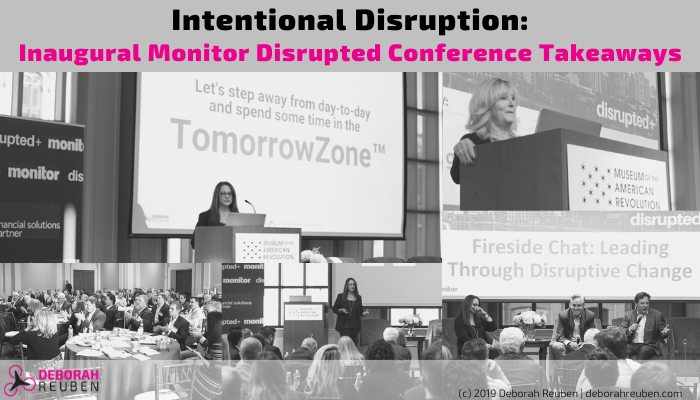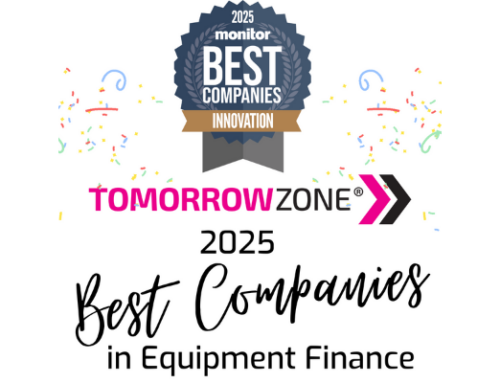
What an adventure! Recently, I attended and contributed to the Inaugural Monitor Disrupted+ Conference in Philadelphia, PA. The event, hosted by Monitor, focused on intentional disruption and facing the innovation challenge for equipment finance. The afternoon was filled with brilliant and innovative speakers who generously shared their unique perspectives.
Throughout the event, there were so many great takeaways from each speaker, that I found myself hastily scribbling pages of notes. Lisa Rafter (Owner/Publisher of Monitor, ABF Journal & Commercial Factor) shared how her company is intentionally disrupting themselves. From a predominantly paper-based publication, Monitor has embraced digital and business model transformation — and this conference is one example of the efforts they are making to reimagine their business for a digital age.
While sharing the stage with a fabulous lineup of insightful speakers, it was my honor to deliver the keynote presentation on Staying Ahead of Industry Disruption. Every industry is facing disruption, and the equipment finance industry is not immune. After analyzing 10 years of quarterly earnings calls, a recent CB Insights tweet revealed that the word “disruption” was mentioned 9x more often than it was 10 years ago. It seems disruption is on the minds of many executives. In my keynote, I shared how leaders can keep up with trends and consider disruptive innovation as they imagine new futures.
I had a blast playing MC and facilitating, throughout the fun and insightful afternoon at the Museum of the American Revolution. Here are some of my takeaways from the Monitor Disrupted conference.
Changing the Game Requires Business Model Innovation
Given the technology possibilities today, what would it look like to create a new equipment finance company from scratch?
During the event, we caught a glimpse of this as Bill Verhelle, CEO of QuickFi shared his startup’s journey over the past 18 months. By focusing on customer experience, speed, simplicity, trust, and transparency, they created a 100% digital business model that can scale.
It takes courage and discipline to create a new business model, and this type of transformative change is especially difficult for established companies. Verhelle advised to avoid the “danger of business model lock-in”: when you invest in a technology that continues doing the same thing. This remains one of the biggest challenges for established companies, as they strive to transform their past successes.
It takes a new set of bold questions to reimagine an established business. However, boldly questioning status quo thinking can lead to the creation of fantastic customer experiences, enabled by new approaches and the latest technology. Transformative change requires you to continually force yourself to avoid the thinking of the past, and explore new possibilities.
Inspiration from non-traditional sources outside the equipment finance industry can spark new ideas for how business could be done in the future. However, implementing change will require a disciplined determination and willingness to separate the innovators from the business-as-usual people. Businesses are designed to protect the current business model, so it takes separation from the core business to do something radically different and design for the customer of the future. Create a safe space to innovate.
When it comes to game changing business model innovation, it can be tempting to give up too soon because in the early stages, it looks as though nothing is happening. Rafe Rosato, Chief Innovation Officer for DLL Group, cautioned that “deception is the enemy”, and you must avoid being deceived by the initial slow progress of game-changer innovations. With disruptive innovation, there is no instant ROI. It’s challenging to know where to place your bets.
It takes a lot of experimentation to find great ideas, which is why it’s vital to have the hard conversations and ask the difficult questions about the true customer experience, such as, “Are we really as good as we think we are?”
Technology Innovation Imperative & the Human Element
Technology is cool, but in order to effectively benefit from it, we must first consider the human element. Change management and culture matter. It’s essential to create space and time for innovative activities that help your team develop a mindset for innovation.
You have to dream a bit — focusing on the customer and vision first, not the technology. According to Don Bryson, Director of Information Technology for Canon Financial Services, starting with vision is vital, but it doesn’t end there. You have to continually ensure that your initiatives align with that vision. There is no end to it, “Innovation is an everyday journey” Bryson shared.
“Yesterday’s nice-to-haves are todays must-haves” said Steve Nelson, Senior Vice President, Director of Operations for TD Equipment Finance. Explaining further, Nelson shared that digital innovation is not an option in today’s world. Digital transformation and moving from manual, paper-based processing, to cloud-based and automated services requires attention to change management. You have to help your team to develop a digital mindset.
Customer Experience is the Heart of Disruptive Innovation
At the heart of disruptive innovation, is the customer experience. “Innovation is about finding a real customer problem and laser focus on solving it” shared Michelle Speranza, Senior Vice President & Chief Marketing Officer for LEAF Commercial Capital, Inc. Further, Speranza explained that 80% B2B customers now expect B2C-like experiences. Addressing this shift in customer expectations requires a shift toward a culture that prioritizes a customer focused experience.
Innovation focused on the customer experience is about helping customers achieve their desired outcomes. Whether it’s a cheeseburger or equipment, customers want an easy, fast, transparent (no surprises) experience.
B2C experiences are influencing B2B CX expectations. CX starts in the online research stage, not at your first direct interaction with the customer. As Yoshi Mua, Owner & Founder of MMedia shared, it’s crucial to have a modern, digital storefront providing valuable content for your target customers.
Leading Disruptive Change
You don’t have to go to innovation school in order to lead innovation. Business leaders, even if they don’t consider themselves to be “technologists,” still need to pay attention to the implications and opportunities of technology trends — taking inspiration from outside our industry, to influence new ways of thinking about how we do equipment finance.
Mindset is key to game-changing innovation: to innovate, you have to be willing to overcome past successes. It’s not easy, but innovation requires a culture that allows people to be willing to fail fast and share ideas. Culture is key.
Challenging status quo thinking requires building new habits, while making an intentional and continuous effort to think differently. We must avoid yesterday’s thinking, “this is how we’ve always done it” and develop a new mindset, which is necessary for transformational change. “Think big, start small, fail fast” as Vanessa Flick, Delivery Manager, Enterprise Business Services for DLL Group shared.
When it comes to the need for disruption, no company is immune. Even software companies need to disrupt themselves and create a culture of innovation. Jeff Lezinski, Senior Vice President of Solution Architecture for Odessa shared how his company is developing “an innovation culture of creative inclusion” which is helping the team learn to fail and feel emboldened to bring new ideas to the table.
As technology innovation progresses at an unprecedented pace, the acceleration of change is increasing. Now more than ever, it’s important to step away from your day-to-day and focus on future possibilities to avoid disruption. The Monitor Disrupted+ conference was a great opportunity to do just that. Choose to be the disruptor, or the disrupted.





